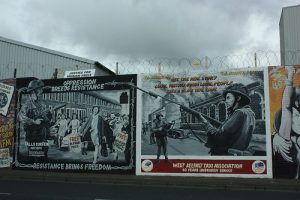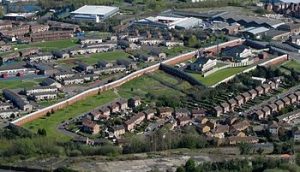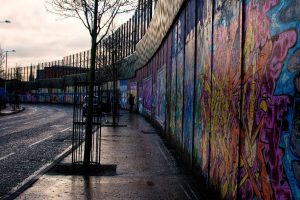 The Troubles was an armed conflict in Northern Ireland between Irish nationalists (who were predominantly Catholic) and unionists (who were predominantly Protestant) that lasted thirty years. At the outset of this struggle, several barricades and barriers were constructed in response to the outbreak of violent protests and riots. Some of the barricades were then converted into “Peace Walls”, separating Catholic (nationalists) and Protestant (unionists) communities in Northern Ireland. Today, around sixty peace walls remain standing. When thinking about borders and exclusions, I think the example of Northern Ireland’s Peace Walls is one of the least talked about cases of exclusion and isolation through the construction of physical barriers.
The Troubles was an armed conflict in Northern Ireland between Irish nationalists (who were predominantly Catholic) and unionists (who were predominantly Protestant) that lasted thirty years. At the outset of this struggle, several barricades and barriers were constructed in response to the outbreak of violent protests and riots. Some of the barricades were then converted into “Peace Walls”, separating Catholic (nationalists) and Protestant (unionists) communities in Northern Ireland. Today, around sixty peace walls remain standing. When thinking about borders and exclusions, I think the example of Northern Ireland’s Peace Walls is one of the least talked about cases of exclusion and isolation through the construction of physical barriers.
This article from the BBC talks about a generational shift in the way the Northern-Irish youth perceive the walls. Younger Northern-Irish residents state that they live in a society that does not have a need for the peace walls. They  state that there is no need for the walls because their generation is not segregated by religious beliefs. For these teenagers, the walls represent a dark part of their history in which they weren’t even alive. These attitudes might change soon. Given the United Kingdom’s decision to leave the European Union, the situation in Northern Ireland might change for the worse and we could see the fortification or even construction of new walls.
state that there is no need for the walls because their generation is not segregated by religious beliefs. For these teenagers, the walls represent a dark part of their history in which they weren’t even alive. These attitudes might change soon. Given the United Kingdom’s decision to leave the European Union, the situation in Northern Ireland might change for the worse and we could see the fortification or even construction of new walls.
Link to the BBC News article: https://www.bbc.com/news/uk-northern-ireland-43991851 “Will NI’s peace walls come down by 2023 to meet 10-year target?”
Other links:
https://northernireland.foundation/projects/sharedfuture/peace-walls/
http://www.bbc.co.uk/history/troubles
-César


I find the reclassification of barriers to “Peace Walls” to be an interesting part of the blog post, particularly because it relates to the idea of re-founding as preservation and it also provokes some consideration of how to change the meaning of a place by using names. I think that these walls have also evolved to be more than just barriers, as you can see in the pictures the walls are covered with graffiti and other art. Art like this bears historical and cultural value. But this also begs the question, should the walls be allowed stand given the divide between what they used to represent and what they have evolved to be?
Furthermore, I believe that the nature of this article is focused around borders and Cesar brings up a good point in questioning how the United Kingdom’s decision to leave the European Union will affect both the constituent members of the UK and of the EU. The EU is not so much a physical body as it is watchful government coalition formed to facilitate positive interactions between member states, taking unique aspects of each member’s needs into consideration. With the United Kingdom’s exit these relationships are going to be strained in new ways, and borders could potentially be a part of it.